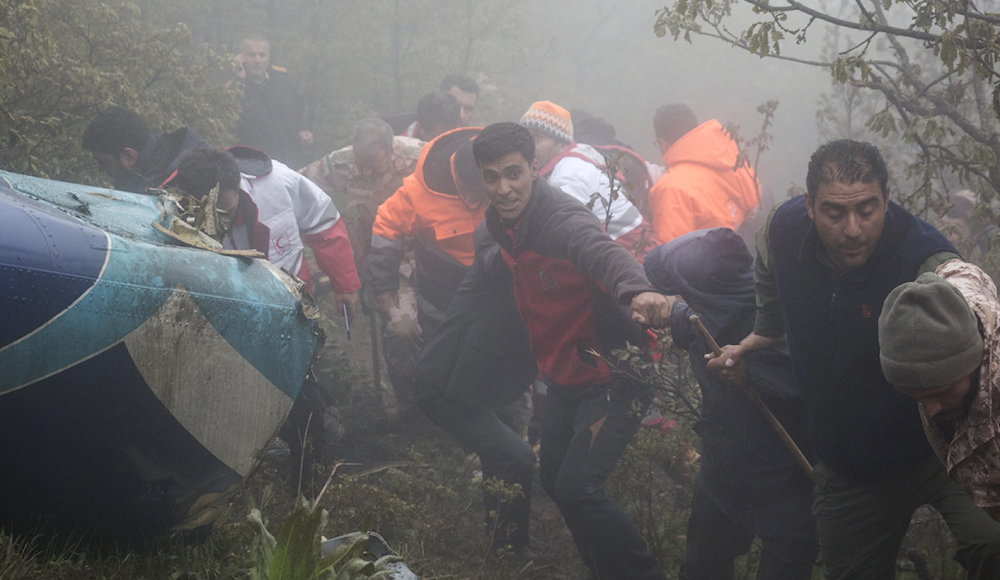How US sanctions crippled Iran's aviation sector: FT
Iran has been unable to update its fleet or get spare parts and maintenance contracts for years due to Western sanctions on Iranian institutions and export prohibitions on aerospace items.
-

In this photo provided by Moj News Agency, rescue members work at the scene of a crash of a helicopter carrying Iranian President Ebrahim Raisi in Varzaghan in northern Iran on May 20, 2024 (AP)
It is still unclear what made the US-made Bell 212 helicopter carrying Iran's late president Ebrahim Raisi and foreign minister crash into a mountaintop near the Azerbaijan border on Sunday.
However, analysts and former officials believe Iran's need for spare parts for its air force due to US and Western sanctions may be to blame.
Earlier Today, Russian Foreign Minister Sergei Lavrov accused the US aviation sanctions, including against Iran, and the ban on the supply of spare parts, of putting people at risk and harming ordinary citizens.
Ali Ansari, founder of the Institute of Iranian Studies at the University of St Andrews told the Financial Times that Iran's air fleet is "old and should not be able to keep flying."
Iran has been unable to update its fleet or get spare parts and maintenance contracts for years due to Western sanctions on Iranian institutions and export prohibitions on aerospace items.
Civilian airliners in the country include a few Airbus A300s, which were no longer built more than a decade ago. Cirium, an aviation statistics organization, reports that the average age of operating planes in its passenger fleet is about 28 years, more than double the global average. Iran Air, the national airline, still operates an A300 that is approximately 40 years old.
Rob Morris, head of Cirium’s consultancy business Ascend, explains that the older the aircraft, the less reliable, detailing how "this is reflected in the average utilization, which at an average of 4.8 hours per day is around half the global average."
Some Western sanctions were removed after Iran accepted the 2015 nuclear agreement with international powers, and Tehran signed contracts worth more than $40 billion with Boeing and Airbus to renew its fleet.
However, that joy was short-lived as Donald Trump withdrew from the deal and slapped hundreds more sanctions.
Carlos Cesnik, professor of aerospace engineering at the University of Michigan explained that BELL 212 and 412 have good safety records, “But in any accident, operating conditions must be taken into account, with weather and maintenance being at the top of the list.”
According to Cirium, Iran now operates 62 Bell helicopters, 13 of which are Bell 212 models. Open-source intelligence experts think the wrecked helicopter had the registration number 6-9207, indicating that it was handed to the Iranian Air Force as early as 1994.
According to Daniel Martin, a financial and trade sanctions partner at law firm HFW, replacement components for technical systems on the Bell helicopter would very probably have been subject to US, UK, and European export restrictions.
Cesnik noted that although helicopters are safer than cars, they are still less safe than planes according to the National Transportation Safety Board), they continue to be a crucial part of military travel in many nations.
In February, the United States National Guard temporarily grounded all of its helicopters following two crashes in a month. A navy helicopter crashed in Malaysia last month, killing ten crew members, and another tragedy killed Kenya's highest-ranking military commander.
Russian helicopters deployed by Colombia's military forces have also had several recent mishaps, most recently a deadly one that killed 9 soldiers.
A helicopter carrying Iranian sports minister Hamid Sajjadi crashed last year while attempting to land on a football field. He survived, but his assistant died, and twelve people were injured. Five months later, a training plane crashed west of Iran, killing two.
Iran's former foreign minister, Mohammad Javad Zarif, blamed US sanctions for the latest disaster and Raisi's death. "These will be recorded in the list of America's crimes against the Iranian people," he declared.

 4 Min Read
4 Min Read








